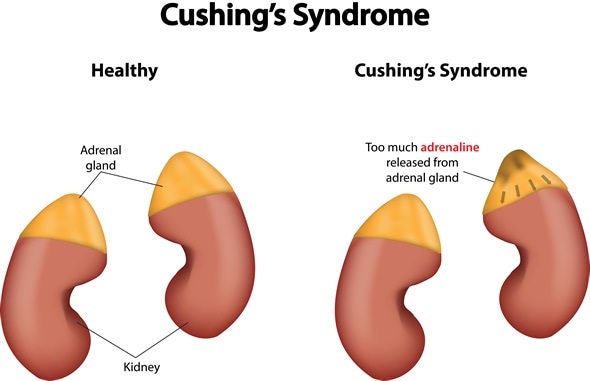Cushing’s syndrome has general symptoms that are similar to several other health conditions and, as a result, it can be difficult to diagnose. It is often a long process that requires a series of medical appointments and diagnostic tests to confirm the diagnosis.

Cushing's Syndrome - Image Copyright: joshya / Shutterstock
Medical History
Some individuals are more likely to be affected by Cushing’s syndrome, which should be considered in the diagnostic process. For example, patients who with a long history of corticosteroid medication use are at risk of the condition.
For this reason, it is important to go over the medical history in detail, with particular attention to any factors that could contribute to causing the condition. Symptoms that could be related to Cushing’s syndrome should be investigated with the diagnosis in mind.
Physical Exam
During the initial stages of diagnosis, a physical examination to elicit any signs of Cushing’s syndrome is required. Changes in appearance that may be indicative of the condition include:
- Increased weight
- Increased body fat distribution around the face, chest and back
- Stretch marks on skin
- Thin fragile skin that bruises easily
- Hypertension
However, these signs are all relatively general and could result from a number of different health conditions. As a result, it is necessary to conduct several tests to narrow down and confirm the diagnosis.
Diagnostic Tests
Diagnostic tests are useful to identify the cause of the symptoms and provide information about the best treatment techniques.
Urinalysis and blood tests are useful to check the levels of cortisol and other hormones that may be responsible for the signs and symptoms. A 24-hour urine collection test involves collecting all urine passed in a 24-hour timeframe, whereas the blood sample is taken at one time.
The levels of cortisol hormone naturally rise and fall throughout the day. The levels usually drop in the evening but in individuals with Cushing’s syndrome they may remain high. A saliva test collected late at night can be indicative of the condition if there are high levels of cortisol present. Another test is the midnight plasma cortisol test.
Low-dose dexamethasone suppression test is another traditional test to diagnose Cushing’s syndrome.
Determining the Cause
Petrosal sinus sampling is a test that helps to distinguish between endogenous and exogenous causes of Cushing’s syndrome. The test involves taking a blood sample from the petrosal sinuses (the major vein that drains the pituitary gland), and from the arm. Both the samples are analyzed for ACTH levels. If the level of ACTH is raised in the petrosal sinus sample, it is likely that the problem is caused by an abnormality of the pituitary gland.
Imaging tests may also be required to visualize the pituitary and adrenal glands, particularly if there is a risk of tumor growth. Magnetic resonance imaging (MRI) and computed tomography (CT) scans are useful to detect abnormalities during diagnosis. Additionally, a DEXA scan is a specific type of X-ray that can be used to investigate bone density and signs of osteoporosis.
Differential Diagnosis
Other conditions or situations that can cause similar symptoms to Cushing’s syndrome include:
- Strenuous exercise or physical stress
- Sleep apnea
- Depression, anxiety and other psychological disorders
- Pregnancy
- Chronic pain
- Emotional or physical stress
- Uncontrolled diabetes
- Excessive alcohol intake
- Obesity
Diagnostic tests can help to make a differential diagnosis and investigate the role of the cortisol hormone in precipitating the changes, which is characteristic of Cushing’s syndrome.
References
Further Reading
Last Updated: Jan 3, 2023